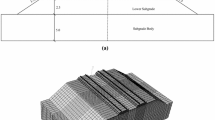Abstract
Introduction
In railway tracks, transition zones are located between the civil structures and the embankments. In this sense, differential settlements take place due to the difference of stiffness between the two, resulting in direct damage to the track. Currently, railway managers have tried, without success, to solve this problem using granular wedges.
Purpose
For this reason, to achieve a continuous and gradual track vertical stiffness in transition zones, a new type of transition wedge has been designed using prefabricated concrete slabs. In addition, it was studied if the new wedge was valid to be installed in urban environments, as it is thought that the transmission of railway vibrations through concrete could be very high.
Method
With this purpose, firstly the design and validation of the new transition wedge has been carried out. To do this, the different alternatives were installed in a test field and the one with the best performance was selected. Once selected, an FEM was used to validate its performance compared to a granular wedge. Secondly, using the FEM of the validated solution, a comparison of the vibrational response of both alternatives was carried out to determine whether the new wedge is suitable for installation in urban environments.
Results and conclusions
The results showed that the new wedge using concrete slabs was an optimal solution to be installed in railway transition zones. However, these wedges did not show an adequate performance in urban environments, so the use of granular wedges was concluded to be more appropriate.













Similar content being viewed by others
References
Paixão A, Fortunato E, Calçada R (2015) Design and construction of backfills for railway track transition zones. Proc Inst Mech Eng Part F J Rail Rapid Transit 229(1):58–70. https://doi.org/10.1177/0954409713499016
Shahraki M, Warnakulasooriya C, Witt KJ (2015) Numerical study of transition zone between ballasted and ballastless railway track. Transp Geotech 3:58–67. https://doi.org/10.1016/j.trgeo.2015.05.001
Esmaeili M, Heydari-Noghabi H, Kamali M (2020) Numerical investigation of railway transition zones stiffened with auxiliary rails. In: Proceedings of the institution of civil engineers-transport, vol. 173, No. 5. Thomas Telford Ltd. p 299–308
Sañudo R, Dell’Olio L, Casado JA, Carrascal IA, Diego S (2016) Track transitions in railways: a review. Constr Build Mater 112:140–157
Wei K, Liu ZX, Liang YC, Wang P (2017) An investigation into the effect of temperature-dependent stiffness of rail pads on vehicle-track coupled vibrations. Proc Instit Mech Eng Part F J Rail and Rapid Transit 231(4):444–454
Abadi T, Pen LL, Zervos A, Powrie W (2019) Effect of sleeper interventions on railway track performance. J Geotech Geoenviron Eng 145(4):04019009
Labrado Palomo M, Roca Barceló F, Ribes Llario F, Real Herráiz J (2018) Effect of vehicle speed on the dynamics of track transitions. J Vib Control 24(21):5118–5128
Code UIC (2008) 719R Earthworks and track bed for railway lines. Paris Union Int des Chemins Fer, p 117
Earthworks, I. U. of Railways (1994) Earthworks and track-bed layers for railway lines. UIC code international union of railways
Real-Herráiz J, Zamorano-Martín C, Real-Herráiz T, Morales-Ivorra S (2016) New transition wedge design composed by prefabricated reinforced concrete slabs. Lat Am J Solids Struct 13(8):1431–1449. https://doi.org/10.1590/1679-78252556
Gallego I, Muãoz J, Rivas A, Sánchez-Cambronero S (2012) Vertical track stiffness as a new parameter involved in designing high-speed railway infrastructure. J Transp Eng 137:12. https://doi.org/10.1061/(ASCE)TE.1943-5436.0000288
Paixão A, Fortunato E, Calçada R (2014) Transition zones to railway bridges: track measurements and numerical modelling. Eng Struct 80:435–443. https://doi.org/10.1016/j.engstruct.2014.09.024
Alves Ribeiro C, Paixão A, Fortunato E, Calçada R (2015) Under sleeper pads in transition zones at railway underpasses: numerical modelling and experimental validation. Struct Infrastruct Eng 11(11):1432–1449
Kouroussis G, Pauwels N, Brux P, Conti C, Verlinden O (2014) A numerical analysis of the influence of tram characteristics and rail profile on railway traffic ground-borne noise and vibration in the Brussels Region. Sci Total Environ 482–483(1):452–460. https://doi.org/10.1016/j.scitotenv.2013.05.083
Forrest JA, Hunt HEM (2006) A three-dimensional tunnel model for calculation of train-induced ground vibration. J Sound Vib 294(4–5):678–705. https://doi.org/10.1016/j.jsv.2005.12.032
Greer R, Manning C (1998) Vibration isolation for railways. Acoust Bull 23:3
Gardien W, Stuit HG (2003) Modelling of soil vibrations from railway tunnels. J Sound Vib 267(3):605–619
Wassgren CR (1997) Vibration of granular materials. Diss California Institute of Technology
Fang X, Tang J (2006) Granular damping in forced vibration: qualitative and quantitative analyses
Sebastian K et al (2019) Vibration reduction in automotive applications based on the damping effect of granular material. Automotive acoustics conference 2017. Springer
Author information
Authors and Affiliations
Corresponding author
Ethics declarations
Conflict of Interest
On behalf of all the authors, the corresponding author states that there is no conflict of interest.
Additional information
Publisher's Note
Springer Nature remains neutral with regard to jurisdictional claims in published maps and institutional affiliations.
Rights and permissions
About this article
Cite this article
Labrado Palomo, M., Alcañiz Martínez, J.H., Zornoza Arnoa, A. et al. Structural and Vibration Performance in Different Scenarios of a Prefabricated Wedge for Railway Transition Zones. J. Vib. Eng. Technol. 9, 1657–1668 (2021). https://doi.org/10.1007/s42417-021-00319-5
Received:
Revised:
Accepted:
Published:
Issue Date:
DOI: https://doi.org/10.1007/s42417-021-00319-5




